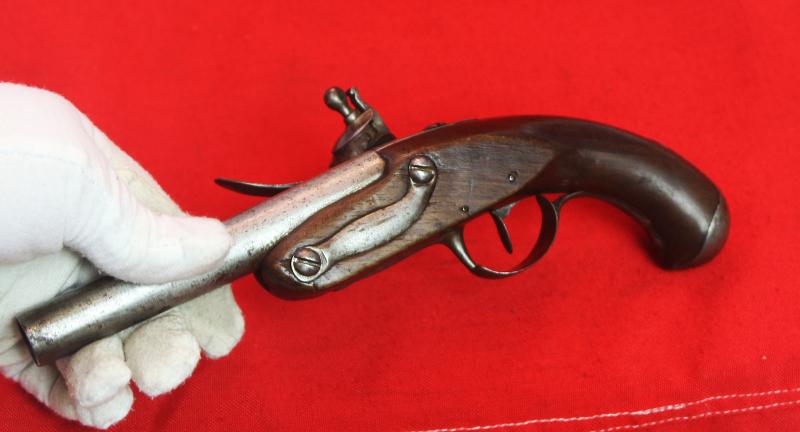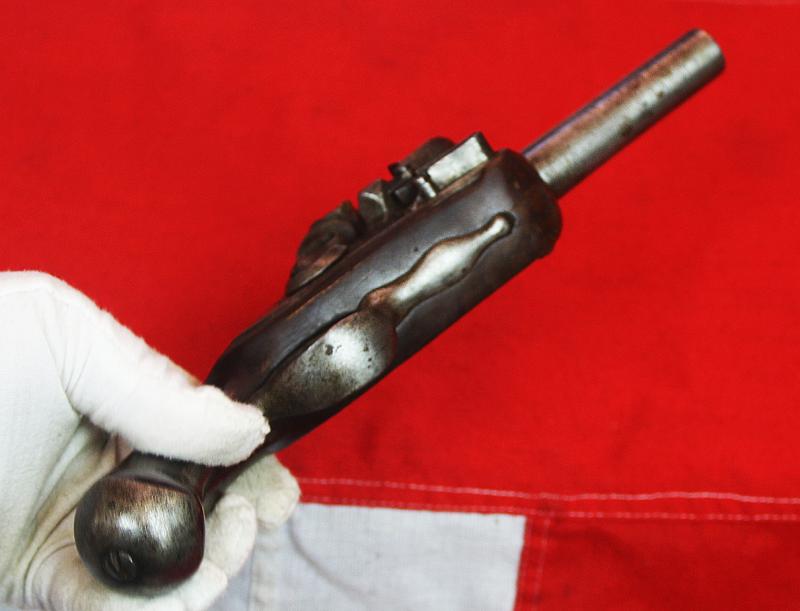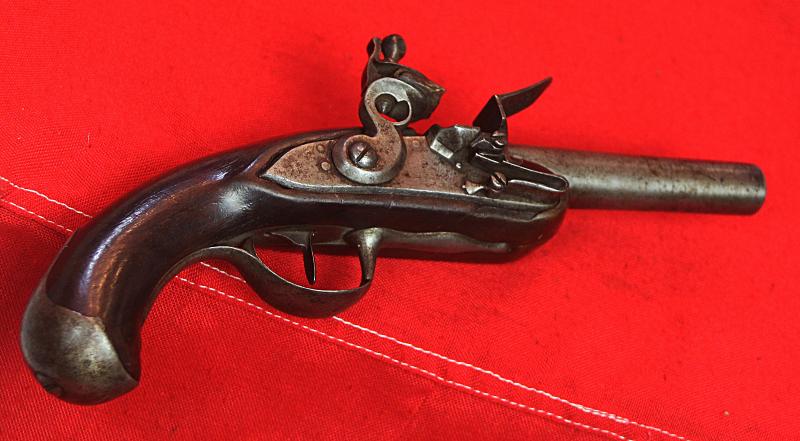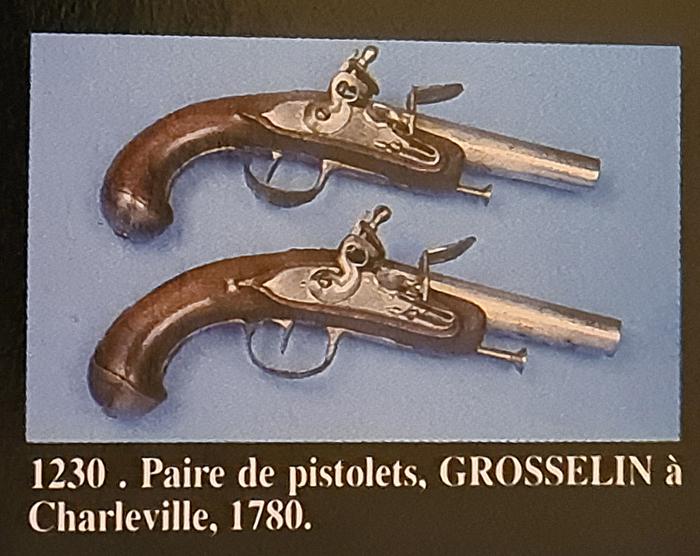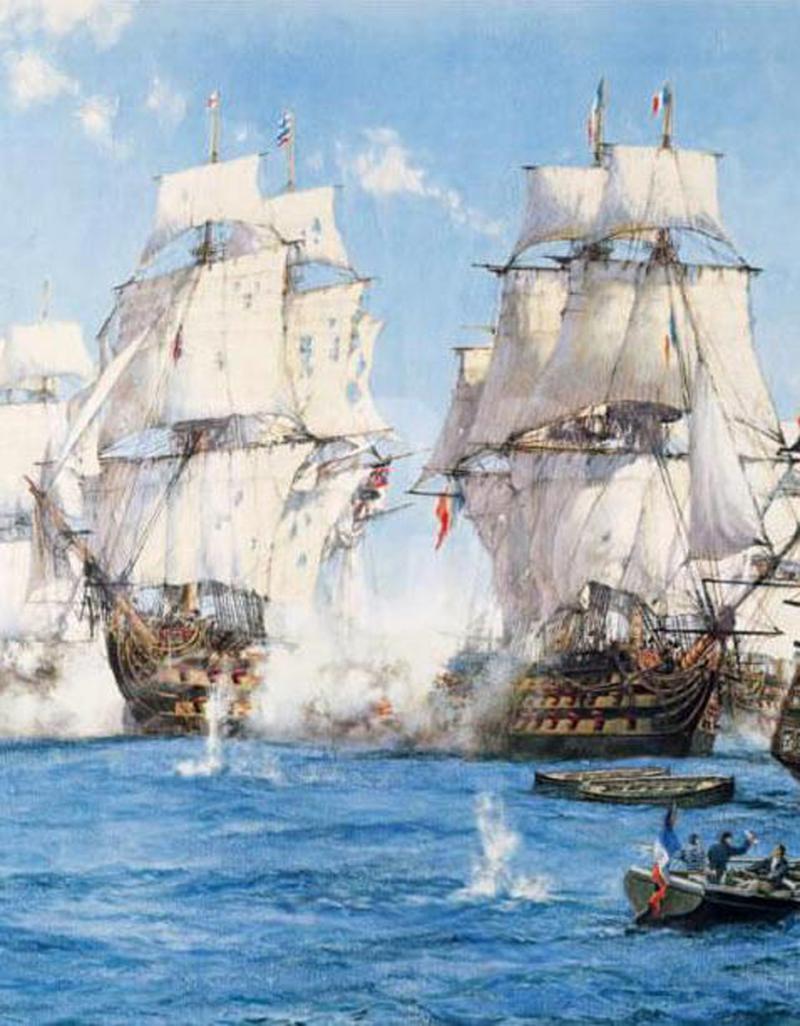1780 Pattern, French Pistolet Maritime, An Officer's Naval 'Sea Service' Belt Pistol. Used By A French Naval Officer From the Battle of the Nile through to Battle of Trafalgar Era
Very probably by Grosselin a Charleville.
Steel barrel, walnut half stock, steel bird's head butt and steel furniture. Flintlock action with pierced heart shaped cock.
French sea service pistols are far more rare than their British equivalents, especially the slightly smaller officer's versions, due to the fact there were fewer French ships, and that so many French ships-of-the-line being captured or sunk by the British Royal Navy, between the 1790's to 1805 Such as when the French Fleet was soundly thrashed in the Egypt campaign at the Nile in 1798, and a little later the French and Spanish fleet, in 1805, were once again soundly thrashed and captured by Admiral Nelson at Cape Trafalgar.
The Battle of the Nile, was a battle that was one of the greatest victories of the British admiral Horatio Nelson. It was fought on August 1, 1798, between the British and French fleets in Abū Qīr Bay, near Alexandria, Egypt.
The French Revolutionary general Napoleon Bonaparte in 1798 made planned for an invasion of Egypt in order to constrict Britain’s trade routes and threaten its possession of India. The British government heard that a large French naval expedition was to sail from a French Mediterranean port under the command of Napoleon Bonaparte
Determined to find the French fleet, he sailed to Egypt once more, and on August 1 1798 he sighted the main French fleet of 13 ships of the line and 4 frigates under Admiral François-Paul Brueys d’Aigailliers at anchor in Abū Qīr Bay.
Although there were but a few hours left until nightfall and Brueys’s ships were in a strong defensive position, being securely ranged in a sandy bay that was flanked on one side by a shore battery on Abū Qīr Island, Nelson gave orders to attack at once. Several of the British warships were able to maneuver around the head of the French line of battle and thus got inside and behind their position. Fierce fighting ensued, during which Nelson himself was wounded in the head. The climax came at about 10:00 PM, when Brueys’s 120-gun flagship, L’Orient, which was by far the largest ship in the bay, blew up with most of the ship’s company, including the admiral. The fighting continued for the rest of the night; just two of Brueys’s ships of the line and a pair of French frigates escaped destruction or capture by the British. The British suffered about 900 casualties, the French about 9,000.
The Battle of the Nile had several important effects. It isolated Napoleon’s army in Egypt, thus ensuring its ultimate disintegration. It ensured that in due time Malta would be retaken from the French, and it both heightened British prestige and secured British control of the Mediterranean.
The Battle of Trafalgar, (October 21, 1805), was a naval engagement of the Napoleonic Wars, which established British naval supremacy for more than 100 years; it was fought west of Cape Trafalgar, Spain, between Cádiz and the Strait of Gibraltar. A fleet of 33 ships (18 French and 15 Spanish) under Admiral Pierre de Villeneuve fought a British fleet of 27 ships under Admiral Horatio Nelson.
Nelson was outnumbered, with 27 British ships of the line to 33 allied ships including the largest warship in either fleet, the Spanish Santísima Trinidad. To address this imbalance, Nelson sailed his fleet directly at the allied battle line's flank, hoping to break the line into pieces. Villeneuve had worried that Nelson might attempt this tactic but, for various reasons, had made no plans for this eventuality. The plan worked almost perfectly; Nelson's columns split the Franco-Spanish fleet in three, isolating the rear half from Villeneuve's flag aboard Bucentaure. The allied vanguard sailed off while it attempted to turn around, giving the British temporary superiority over the remainder of their fleet. In the ensuing fierce battle 20 allied ships were lost, while the British lost none.
Nelson's own HMS Victory led the front column and was almost knocked out of action. Nelson was shot by a French musketeer during the battle, and died shortly before it ended. Villeneuve was captured along with his flagship Bucentaure. He attended Nelson's funeral while a captive on parole in Britain. The senior Spanish fleet officer, Admiral Federico Gravina, escaped with the remnant of the Franco-Spanish fleet (a third of the original number of ships); he died five months later of wounds sustained during the battle.
The victory confirmed the naval supremacy Britain had established during the course of the eighteenth century, and was achieved in part through Nelson's departure from prevailing naval tactical orthodoxy.
At the same time this pistol was made there was another version, same form and size, called the 1779 pattern so called 'sea-dog's head' pistol, however, it had instead of the steel bird's head butt that this has, it had a carved dog's head.
A photo in the gallery from around 35 years ago of an article about these very form of pistols by Grosselin of Charleville, an identical pair, yet also, one of them, like this one was un-named.
The condition is jolly good, excellent tight spring and action. Rammer lacking
Code: 25253
1800.00 GBP



